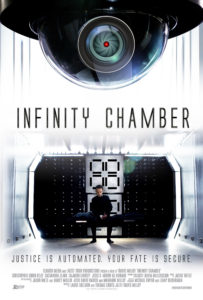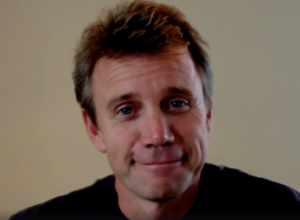 High Concept ideas sound very exhilarating, but are no easy task. From the writer of the 2009 hit Pandorum; comes Travis Milloy’s latest Sci-Fri Thriller entitled Infinity Chamber. Infinity Chamber was a personal project that took about 7-8 years in the process, which came about from a news report on automated prisons. There was a high probability that the film would be in development forever; so, he acted by forcing himself into a corner renting a space in an industrial area and building the set, while simultaneously completing the script. This unconventional method worked hand in hand and inspired Milloy with the script that same night.
High Concept ideas sound very exhilarating, but are no easy task. From the writer of the 2009 hit Pandorum; comes Travis Milloy’s latest Sci-Fri Thriller entitled Infinity Chamber. Infinity Chamber was a personal project that took about 7-8 years in the process, which came about from a news report on automated prisons. There was a high probability that the film would be in development forever; so, he acted by forcing himself into a corner renting a space in an industrial area and building the set, while simultaneously completing the script. This unconventional method worked hand in hand and inspired Milloy with the script that same night.
Obviously, many complications exist for creating a futuristic automated prison cell. It took a year to build the automated prison cell set, as he basically built that entire world by himself with one power drill and 5,000 metal screws to make it look real. Luckily, he had Production Designer, Tom Duffield (Hell or High Water, Lone Survivor, Patriots Day) nearby to offer advice and suggestions. The irony is that it took a year to build the set, however had to be torn down within 18 hours.
Now that the set was completed, the question was how to make it visually cinematic on screen. The film had two different Cinematographers attached to the project. Jason Nolte shot mostly everything in the cell. Nolte brought an interesting look making it very clean, sterile, and blue feel to it. On the flip, that was contrasted by a warmer, sunlight, orange template for outside of the cell, which was shot by Marty Mullin. The two different styles meshed well creating a beautiful film. In relation to the camera placement, Milloy initially envisioned it as more of the handheld style with movement within the cell. But as they shot, it transitioned into the traditional framing with simpler shots on a locked down tripod to show off the world and the set the best way.
Another dilemma was finding that one person to portray the film through. Milloy explains. “I knew having one character carry the whole movie, I had to find the right person. When I had met Christopher Kelly, we were auditioning for a different movie; he came into read as a cold audition and just blew me away. Right away, I was like this guy is interesting, super talented, and there’s a lot to him. We became friends and stayed in touch.”
Milloy credits much of the story success in the editing. “The story was definitely altered. Editing is a whole art in itself; I mean you can find your movie, you can lose your movie, you can figure it out through the editing process. The first edit didn’t work. There was something not working about the story; the rhythm, the pacing, the structure wasn’t really paying off. I went in a second time and restructured the story, moved things around, especially in the first act. What happens a lot of the time, especially when the director is editing himself; you over edit, you are getting impatient, you want to move things faster and faster. The second pass also failed. I stepped back and then went in again.” As Milloy faced some obstacles during editing, he inserted some beautiful match cuts to transition between the two worlds.
Jesse D. Arrow provided the voice of Howard, the Artificial Intelligence type character as his voice naturally sounded dark, scary, with a synthesized feel to it, but concurrently attained a level of humanity. Milloy clarifies on the AI voice process. “I basically made his voice gradually more unstable. As the movie progresses, the tones of his voice sound like he’s breaking down or losing something. It was a very subtle filtration that I did to his voice from start to finish.”
Milloy caps off, “I love post-production, I love the art of editing, I love sound design.”
Experience Travis Milloy’s high concept Sci-Fi Thriller, Infinity Chamber on VOD.





